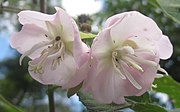| Dombeya burgessiae | |
|---|---|

| |
| Flowers | |

| |
| Botanical illustration | |
|
Scientific classification
| |
| Kingdom: | Plantae |
| Clade: | Tracheophytes |
| Clade: | Angiosperms |
| Clade: | Eudicots |
| Clade: | Rosids |
| Order: | Malvales |
| Family: | Malvaceae |
| Genus: | Dombeya |
| Species: | D. burgessiae
|
| Binomial name | |
| Dombeya burgessiae | |
| Synonyms [2] | |
|
List
| |
Dombeya burgessiae, the rosemound, is a widespread species of flowering plant in the family Malvaceae. [3] It is native to seasonally dry areas of tropical Africa, and has been introduced to Pakistan, Assam, and Trinidad and Tobago. [2] A variable shrub or multi-stemmed tree from 2 to 8 m (7 to 26 ft) tall, it is used for its fiber (for ropes and baskets), wood (bows and tool handles), its edible pith, and for friction sticks to make fire. [4] It is occasionally planted as an ornamental. [4]
References
- ^ Botanic Gardens Conservation International (BGCI).; IUCN SSC Global Tree Specialist Group. (2019). "Dombeya burgessiae". IUCN Red List of Threatened Species. 2019: e.T146224959A146224961. doi: 10.2305/IUCN.UK.2019-2.RLTS.T146224959A146224961.en. Retrieved 10 September 2022.
- ^ a b "Dombeya burgessiae Gerrard ex Harv". Plants of the World Online. Royal Botanic Gardens, Kew. Retrieved 10 September 2022.
-
^
"Dombeya burgessiae Rosemound". The Royal Horticultural Society. 2022. Retrieved 10 September 2022.
Other common names; Wedding Flower [3]
- ^ a b Fern, Ken (20 July 2022). "Dombeya burgessiae Gerrard ex Harv. Malvaceae". tropical.theferns.info. Tropical Plants Database. Retrieved 10 September 2022.
| Dombeya burgessiae | |
|---|---|

| |
| Flowers | |

| |
| Botanical illustration | |
|
Scientific classification
| |
| Kingdom: | Plantae |
| Clade: | Tracheophytes |
| Clade: | Angiosperms |
| Clade: | Eudicots |
| Clade: | Rosids |
| Order: | Malvales |
| Family: | Malvaceae |
| Genus: | Dombeya |
| Species: | D. burgessiae
|
| Binomial name | |
| Dombeya burgessiae | |
| Synonyms [2] | |
|
List
| |
Dombeya burgessiae, the rosemound, is a widespread species of flowering plant in the family Malvaceae. [3] It is native to seasonally dry areas of tropical Africa, and has been introduced to Pakistan, Assam, and Trinidad and Tobago. [2] A variable shrub or multi-stemmed tree from 2 to 8 m (7 to 26 ft) tall, it is used for its fiber (for ropes and baskets), wood (bows and tool handles), its edible pith, and for friction sticks to make fire. [4] It is occasionally planted as an ornamental. [4]
References
- ^ Botanic Gardens Conservation International (BGCI).; IUCN SSC Global Tree Specialist Group. (2019). "Dombeya burgessiae". IUCN Red List of Threatened Species. 2019: e.T146224959A146224961. doi: 10.2305/IUCN.UK.2019-2.RLTS.T146224959A146224961.en. Retrieved 10 September 2022.
- ^ a b "Dombeya burgessiae Gerrard ex Harv". Plants of the World Online. Royal Botanic Gardens, Kew. Retrieved 10 September 2022.
-
^
"Dombeya burgessiae Rosemound". The Royal Horticultural Society. 2022. Retrieved 10 September 2022.
Other common names; Wedding Flower [3]
- ^ a b Fern, Ken (20 July 2022). "Dombeya burgessiae Gerrard ex Harv. Malvaceae". tropical.theferns.info. Tropical Plants Database. Retrieved 10 September 2022.






